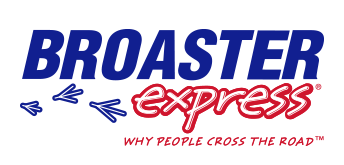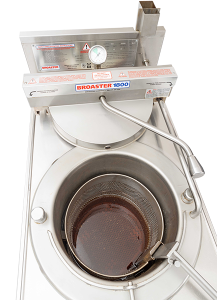How entrepreneurs can cash in on the carryout food craze
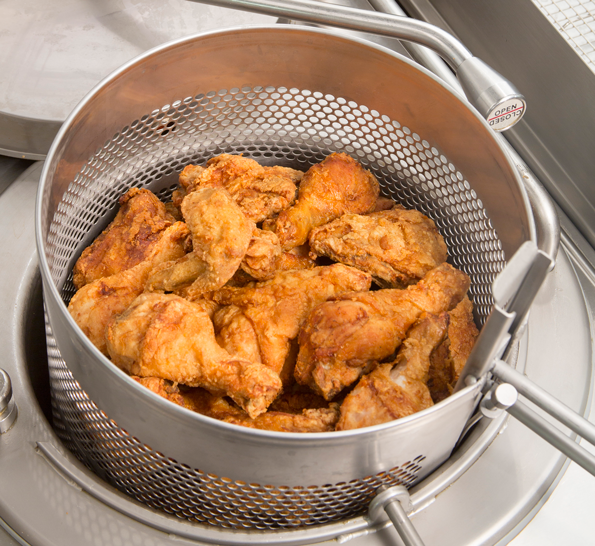 One of America’s most beloved foods is creating the perfect opportunity for restaurants, bars and convenience stores to capitalize on the trend toward carryout dining.
One of America’s most beloved foods is creating the perfect opportunity for restaurants, bars and convenience stores to capitalize on the trend toward carryout dining.
“Chicken is the most popular protein in the U.S.,” says Greg West, senior vice president of marketing and food innovation for Broaster Company, maker of Genuine Broaster Chicken® and premium-quality Broaster Fryers. “In fact, the per capita consumption of chicken has continued to grow for the past 30 years.”
There has also been a resurgence of fried chicken over the past decade.
Fad diets come and go. The “all fat is bad” fad is a thing of the past. Nowadays, there is trend toward “balanced diets” that limit the consumption of things like trans fats, sugars, red meats, etc. With those balanced diets comes a desire to eat things that simply taste good — so long as they are eaten in moderation.
“Many of today’s consumers are more than willing to sit down and eat a delicious piece of fried chicken,” West says. “But they might opt for a side of Brussels sprouts or a whole-grain roll. Of course, there are also plenty of consumers who are still going to want a big pile of mashed potatoes and a biscuit.”
Regardless, the cornerstone for more than 65 years has been some crispy, tender, abundantly flavorful fried chicken.
Consumers flocking toward carryout dining
While some consumers are brave enough to try frying at home, most would rather pay someone else to do it. Consumers just want to know they can trust whomever they are paying to fry it.
Today’s consumers also want to know that they are eating “real food”. They want to know where the food comes from, how it’s prepared and what the ingredients are.
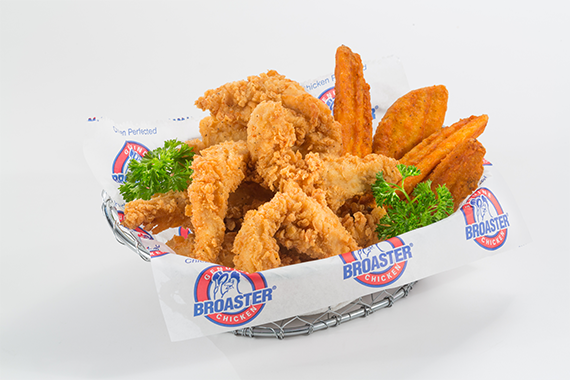 Fried chicken is a perfect match.
Fried chicken is a perfect match.
Fried chicken is actually a core comfort food. Genuine Broaster Chicken, for example, starts with fresh and never frozen chicken that is typically sourced from family farms. The chicken is marinated primarily with water and salt, breaded with wholesome flour and secret spices, and pressure fried in one of Broaster Company’s state of the art Broaster Fryers.
Numerous segments of the broader food service industry have gotten in on the fried chicken phenomenon, from quick service chains to supper clubs. Now you’re seeing places like bars, grocery stores and convenience stores diversifying into fried chicken.
The coronavirus crisis has created challenges for the food service industry, especially restaurants that have historically relied on dine-in customers. With those challenges, however, come opportunities — opportunities to pursue new products that make carryout dining a great alternative. That is where fried chicken, an American staple since the 1950s, is coming into play.
Even before COVID-19 shut down large swaths of the restaurant industry, there was a trend toward take-home dining, whether that be carryout, curbside, home delivery or catering. The fact that restaurant dining rooms have been shut down for the past couple of months has only accelerated this trend.
As the economy begins to reopen, hopefully over the next few months, it is still likely that restaurants will have to modify their approach to serving customers in order to comply with social distancing guidelines. For example, if a restaurant has to reduce its seating capacity by 30 to 50%, it will need to do something to make up for that lost revenue. Creating a more appealing carryout business is the logical answer.
At the same time, some restaurants will not be able to make a good transition to a carryout business model. This is where opportunity arises for places like local bars and convenience stores. Consumers already frequent these businesses. Why not take home a box of fried chicken for a nice family dinner that evening?
“Consumers are looking for good, clean food from trusted local businesses,” West says. “If an independent restaurant, bar or convenience store can deliver a great food product with a great customer experience, they can thrive in this new world we are living in.”
5 steps to creating a profitable carryout food business
The typical restaurant, bar or convenience store has not focused much attention on a carryout food service. But if that is what they are looking to do, there are five main considerations.
- Create a menu strategy.
A popular tactic is to narrow down the food options that will be available for carryout. This makes execution easier while also helping ensure a consistently high-quality product. Additionally, adding an item that lends itself well to carryout is effective. Fried chicken is a great example.  Create a packaging strategy. The typical restaurant or bar is used to serving food on dinnerplates. That obviously isn’t going to work for a carryout service. It’s important to identify a packaging strategy that will help create a good customer experience without being cost-prohibitive. A reliable supplier will also be necessary.
Create a packaging strategy. The typical restaurant or bar is used to serving food on dinnerplates. That obviously isn’t going to work for a carryout service. It’s important to identify a packaging strategy that will help create a good customer experience without being cost-prohibitive. A reliable supplier will also be necessary.- Develop a marketing plan. You have to tell the marketplace what you are offering. Consumers need to know that you are significantly in the carryout business now, as opposed to just dabbling in it. The more consumers know you are serious, the more they’ll feel like they can trust you and should order from you.Independently owned restaurants and bars have an advantage when it comes to marketing a new product or service. They can typically move quickly and do some creative things on social media and with local mailings. They can also create loyalty programs to help drive referrals and repeat business. More of today’s consumers prefer shopping local, which also works in an independent’s favor.
- Create a platform for ordering. There are a lot of good, local businesses that still take plenty of orders over the phone with pen and paper. But let’s face it, consumers want to order online these days — especially when buying carryout food.A good online ordering platform will make it easy for businesses to sell their products, while also enhancing the customer experience. Several providers offer mobile apps to help in this area. Two immediately come to mind: Swipeby and ChowNow. These platforms fully integrate with a business’s existing branding, but run “in the background,” so to speak.
“The added benefit of using an app like this is that the food delivery part of the transaction is still the food provider, whether that’s a restaurant, bar or convenience store,” West says. “Consumers really value that, especially in this post-virus environment we are living in.”
- Operational execution. Businesses need to think about how they are going to set up their chicken-frying operation. Part of this answer is based on their existing operation, i.e. floor space, existing kitchen equipment, traffic flow, etc. The other part is based on how much chicken they expect to sell.“We’ve had some customers who had such a substantial carryout chicken business that they needed a separate kitchen,” West says.
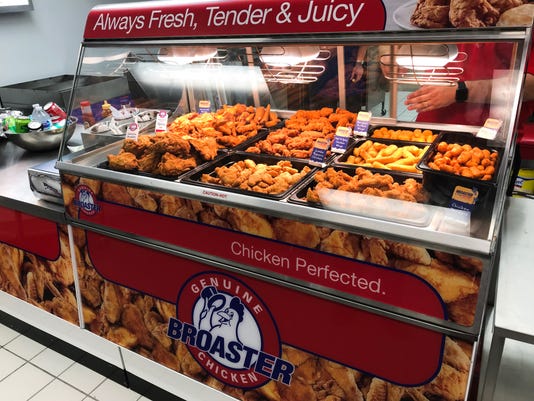 That might not always be the case, but businesses will need to think about how to incorporate the new chicken business into their existing kitchen operation. They may also need to think about how they will go about delivering a pleasant curbside service. Where will customers pull up? How will they alert you that they have arrived? How will your staff know when to respond? Systems and processes are needed to ensure that the customer is happy with not only their warm, delectable box of fried chicken, but also the customer service experience you provide.
That might not always be the case, but businesses will need to think about how to incorporate the new chicken business into their existing kitchen operation. They may also need to think about how they will go about delivering a pleasant curbside service. Where will customers pull up? How will they alert you that they have arrived? How will your staff know when to respond? Systems and processes are needed to ensure that the customer is happy with not only their warm, delectable box of fried chicken, but also the customer service experience you provide.
And make no mistake, delicious fried chicken is not a foregone conclusion. Product quality can fluctuate greatly from one provider to the next.
“A fresh, hand-breaded chicken is always the best and most preferred,” West says.
Genuine Broaster Chicken provides a seamless single-source solution for restaurants, bars and convenience stores looking to spread their wings in the carryout chicken business. Broaster Company provides a pre-marinated chicken, which greatly simplifies the preparation process. Cooks can simply open up the bag of fresh chicken, drain off any excess marinade, and then bread and pressure fry the chicken according to the trademark recipes.
How to select the best pressure fryer for chicken
Pressure frying chicken is an easier, safer and more productive method than deep frying or pan frying.
Pressure fryers cook chicken under controlled pressure in a sealed environment. That results in chicken that is more tender, juicy and flavorful, and less saturated with oil. Pressure fryers also provide higher production rates for a faster return on investment.
While it is clear that a pressure fryer is the right equipment for a carryout chicken business, restaurants and bars, convenience stores, and even grocery store delis will need to select the proper size to fit their needs.
“Think about when your peak time is going to be, which is typically 4 to 7 on a Friday night for a lot of meal solution businesses,” West says. “Then figure out how much chicken you think you’ll sell during that timeframe. That will help you determine what size fryer you need, or if you may need multiple fryers.”
Businesses should also think about the space they have available to house the new pressure frying equipment. Pressure fryers that are more compact in size can come in handy for kitchens already pressed for space. Additionally, look for fryers that incorporate the oil filtering equipment within the same footprint.
Safety and cleaning also go hand in hand. The easier a fryer is to clean, the safer the overall operation is going to be. Look for fryers with high-quality casters that make it easier to move the fryer around, which makes it easier for kitchen staff to gain 360-degree access to make cleaning easier.
Broaster Company offers a range of pressure fryers that addresses all of these key needs.
- 16 to 48 pieces of bone-in chicken per load, depending on model
- 16, 18 or 24-inch overall width
- Gas or electric, depending on model
- Touch-screen controller makes operating much easier than the old-school models with dials
Portable Ventless Hood System
Provides necessary vapor removal requirements for all electric models of Broaster pressure fryers.
- Easy to install
- Eliminates need for roof modifications
- Built-in fire suppression system
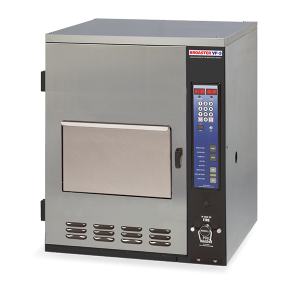 Ventless Countertop Pressure Fryers
Ventless Countertop Pressure Fryers
Self-venting units that do not require a hood in most municipalities depending on local fire codes. Although they don’t produce the same throughput as other models, they can come in handy for places that are limited on space and may only produce a low to moderate volume of chicken, such as a bar or convenience store.
This new high-efficiency series of pressure fryers is being introduced in June 2020. These premium-quality fryers represent the best in terms of energy efficiency, labor efficiency, fry oil efficiency and footprint.
- Advanced microprocessor controller
- Cooking cycle starts automatically with lid closure
- Automatic controlled pressure release at programmed time
- Automatic oil filtration between cook cycles
To learn more about a Genuine Broaster Chicken trademark food program, or how Broaster Fryers can help your business cash in on the carryout food craze, contact us today.
#BetterBeBroaster
From our Broaster family to yours—wishing you a safe, joyful, and flavor-filled Independence Day! 🇺🇸🎆🍗
#BetterBeBroaster #HappyFourth #IndependenceDay #BroasterChicken
Jul 4

Big power. Small footprint. 🔥
The Broaster 1800 is your high-performance pressure fryer—built for busy kitchens that need speed, consistency, and quality without taking up extra space.
✅ Round cooking well
✅ High-volume output
✅ Easy to use, easy to clean
Perfect for operators who want to serve legendary Broaster Chicken. Visit us online at Broaster.com/contact for a quote!
#BetterBeBroaster #Broaster1800 #PressureFryer #CompactPower #BroasterEquipment #SmartKitchenSolutions
Jul 3

Golden. Crispy. Irresistible. 🍤
Our Beer Battered Shrimp delivers pub-style flavor with a light, crunchy bite—ready in minutes. Serve it as a snack, app, or add it to a combo!
✅ Premium tail-off shrimp
✅ Signature beer batter coating
✅ Quick prep, no hassle
Bring the coastal vibes to your menu—no ocean required. 🌊 Now available nationwide through @dotfoodsofficial. Learn more here online at Broaster.com
#BetterBeBroaster #BeerBatteredShrimp #SeafoodMadeSimple #FrozenFoodDoneRight
Jul 2

"I am starving for Broaster Chicken" We are, too, buddy… We are, too. #BetterBeBroaster
Jul 1

Where do you get your Broaster Chicken fix? 🍗
Shout out your go-to spot and tag them in the comments! ⬇️ Let’s show some love to the places serving up that crispy, juicy goodness! 🙌
#BetterBeBroaster #BroasterChicken
Jun 29

#FAQFRYday 💬 "How much does your equipment cost?"
Great question! 💡 Pricing can vary based on your setup, needs, and location — so the best way to get an accurate quote is by connecting with your local distributor.
Ready to get started? We’ll point you in the right direction 👉 Visit Broaster.com/distribution
Jun 27

Our friend from Youtube says, "The chicken was juicy and the skin was flavorful."
Now we`re hungry for Genuine Broaster Chicken 😋
Jun 24

#NationalOnionRingDay calls for something crispy, golden, and unforgettable! 🧅
Let’s talk about one of our fan-favorite frozen picks — Broaster’s Beer Battered Onion Rings 🍺✨
Made with whole, sweet Spanish onion slices (never processed or extruded!), these rings are packed with bold flavor and crave-worthy crunch your customers will love bite after bite.
Now available nationwide through @dotfoodsofficial
Jun 22

#FAQFRYday 🍗💡 "Why is my chicken coming out too dark?"
If your chicken’s looking a little too golden… it might be your oil! 🔍
👨🍳 Pro Tip: It’s probably time to filter or replace your oil. Regular oil maintenance keeps your pressure fryer in top shape and your chicken perfectly crispy every time.
✅ Clean oil = Better taste, better color, better results!
Jun 20

Why Join the Broaster Express® Program? 🤔👇
🔥 Top-Quality, Ready-to-Cook Menu – Serve great food fast!
⚙️ Efficient Equipment – Get cooking with ease and speed.
🛢️ High-Quality Cooking Oils – Better taste, better consistency.
📦 Branded Packaging – Looks as good as it tastes!
👕 Branded Apparel – Dress the part, serve with pride.
🌟 National Brand Recognition – Trusted nationwide.
📢 Marketing Support – We help drive traffic to your store!
👨🍳 On-site Training – Master your kitchen with our expert help.
🚫 No Fees. No Royalties. No Franchise Contract. – Just pure profit potential!
📍 Store Locator & Website Support – Be found, be chosen, be loved.
✨ Boost your business with Broaster Express® ✨ Learn more online at Broaster.com/trademark-food-programs
Jun 18

🌟 Operator Spotlight Time! 🌟
Say hello to @nicksquorum in downtown Omaha, NE — where classic supper club vibes meet modern-day deliciousness!
From tableside Roasted Prime Rib with Yorkshire pudding (yes, please 😍) to a daily fish fry featuring crispy beer-battered cod, they’re serving up comfort food dreams with a gourmet twist. And don’t even get us started on that lobster mac & cheese and double-baked stuffed potatoes… pure indulgence. ✨
Big thanks to Nick’s Quorum for being a Genuine Broaster Chicken Operator ❤️ #BetterBeBroaster
Jun 17

Happy Father’s Day to all the dads out there! Whether you’re manning the grill or enjoying some well-deserved pressure-fried chicken, here’s to a day full of flavor and appreciation. #BetterBeBroaster
Jun 15

#FAQFRYday How long does it take to smoke ribs in the #Smokaroma? LESS THAN AN HOUR! Yeah, you heard that right. With our pressure smoking technique, you will have the juiciest, flavor packed ribs in about 45 minutes.
Learn more online at broaster.com/equipment/smokaroma
Jun 13

Check out how @thelodgesouthhaven took our Genuine Broaster Chicken tenders 🍗 and turned it into an interesting, delicious appetizer! They start by skewering Genuine Broaster Chicken tenders with their sweet Belgium waffles. 🧇 Then, the dish is drizzled with farm-fresh blueberry jam. 🫐 It is served with 100% pure Michigan maple syrup for dipping.
We love to see how you use your own creativity with our #GenuineBroasterChicken!
Jun 12

What do we hear all the time about our Genuine Broaster Chicken®? BEST. CHICKEN. EVER. What do you think? 😉 #BetterBeBroaster #GenuineBroasterChicken
Jun 10

#FAQFryDay: How do I clean my Broaster Ventless Fryer?
** Allow the unit to cool completely before cleaning or serious burns could occur.
1. Turn power off, disconnect from main power supply & remove access door
2. Remove the food basket & basket lift platform for easy cleaning.
3. Unlatch filter tray & pull tray out with your free hand under the tray & swing tray down 45º. With both hands, pull the tray out towards you.
4. Remove air filter & grease filter from filter tray; set air filter aside so it will not get wet while cleaning other parts. NOTE: The air filter has steam passing through it during the cooking process, let the air filter dry out overnight before reinstalling it into the filter tray.
5. Raise element by placing element arm above element retainer & allow oil to drip from it for a few minutes.
6. Carefully remove cooking pot, pour oil through strainer & filter paper or discard used oil properly. The cooking pot can be cleaned in the sink or dishwasher. When changing oil, soak cooking pot, food basket, & basket lift platform in Broaster’s Cooking Well Cleaner (99500) for a minimum of 15min to a maximum of 12hrs.
7. Remove splash tray for easy cleaning.
8. Wipe element guard & interior of chamber with clean cloth or paper towel to remove any crumbs. Clean walls, floor & ceiling of cooking chamber.
9. Completely clean outside panels with non-abrasive stainless steel cleaner & polish.
10. Product door, food basket, lift platform, cooking pot, filter tray, grease filter, and splash tray can be removed & placed in the dishwasher. If using a dishwasher or soap, you will need to neutralize parts with a vinegar & water solution. *There is no need to neutralize parts when cleaning with Broaster’s Cooking Well Cleaner (99500).
11. Place splash tray & reassembled filter tray back into unit. BE SURE magnet end of grease filter is on the right side of filter tray when in place. Return filtered oil or add fresh oil to Cold Oil Level Line. Replace cooking pot, lower the element into the cooking pot, replace basket lift platform & food basket. Unit is ready to operate.
Jun 6

